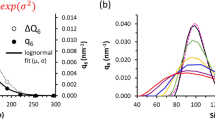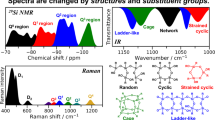Abstract
Various factors influencing the performance of a Hadamard transform time-of-flight mass spectrometer (HT-TOFMS) have been investigated. Using a nitrogen corona discharge to produce an ion stream of N +2 , N +3 , and N +4 , it is found for spectra containing only N +4 that the signal-to-noise ratio (SNR) closely approaches the value calculated from the ion background by assuming that the ion background follows a Poisson distribution. In contrast, for a more intense beam containing N +2 , N +3 , and N +4 , the SNR is less than its theoretical value because of the appearance of discrete spikes in the mass spectrum caused by deviations in the actual modulation sequence from the ideal one. These spikes can be reduced, however, by decreasing the modulation voltage. Under these optimized conditions, the pseudo-random sequence length is varied to understand how it alters SNR, mass resolution, and scan speed. When the length of the pseudo-random sequence is doubled, the SNR increases by √2 while the time necessary to record a mass spectrum also doubles. Mass resolution can be varied between 500 and 1200 at m/z = 609 as the sequence length, modulation speed (10 MHz, 25 MHz), and acquisition rate (up to 50 MHz) are changed. Scan speeds of 6000 passes per s can be obtained using a sequence containing 4095 elements modulated at 25 MHz. The capability to tailor the HT-TOFMS to increase the scan speed and resolution with a constant 50% duty cycle makes the technique extremely appealing as a mass analyzer for measuring rapid changes in the composition of an ion stream.
Similar content being viewed by others
References
Cotter, R. J. Time-of-flight Mass Spectrometry, Washington, DC: ACS Symposium Series No. 549, 1994.
Karas, M.; Bachmann, D.; Hillenkamp, F. Anal. Chem. 1985, 57, 2935–2939.
Zenobi, R.; Knochenmuss, R. Mass Spectrom. Rev. 1999, 17, 337–366.
Chien, B. M.; Michael, S. M.; Lubman, D. Int. J. Mass Spectrom. 1994, 131, 149–179.
Guilhaus, M.; Selby, D.; Mlynski, V. Mass Spectrom. Rev. 2000, 19, 65–107.
Brock, A.; Rodriguez, N.; Zare, R. N. Anal. Chem. 1998, 70, 3735–3741.
Brock, A.; Rodriguez, N.; Zare, R. N. Rev. Sci. Instrum. 2000, 71, 1306–1318.
Harwit, M. D.; Sloane, N. J. Hadamard Transform Optics. Academic Press: London, 1979, pp 214–216.
Marshall, A. G. Fourier, Hadamard, and Hilbert Transforms in Chemistry. Plenum Press: New York, 1982, pp 45–67.
Treado, P. J.; Morris, M. D. Spectrochim. Acta Rev. 1990, 13, 355–375.
Treado, P. J.; Morris, M. D. Anal. Chem. 1989, 61, 723A-734A.
Barnidge, D. R.; Nilsson, S.; Markides, K. E.; Rapp, H.; Hjort, K. Rapid Comm. Mass Spectrom. 1999, 13, 994–1002.
Ervin, K. M.; Armentrout, P. B. J. Chem. Phys. 1985, 83, 166–189.
Krutchinsky, A. N.; Chernushevich, I. V.; Spicer, V. L.; Ens, W.; Standing, K. G. J. Am. Soc. Mass Spectrom. 1998, 9, 569–579.
Vlasak, P. R.; Beussman, D. J.; Davenport, M. R.; Enke, C. G. Rev. Sci. Instrum. 1996, 67, 68–72.
Montgomery, D. C. Design and Analysis of Experiments; 4th ed. Wiley: New York, 2001, pp 466–472.
Wilhelmi, G.; Gompf, F. Nucl. Instr. Meth. 1970, 81, 36–44.
Rodriguez, N. Ph.D. Dissertation, Department of Chemistry. Stanford University, 1999.
Hanley, Q. S. Appl. Spectrosc. 2001, 55, 318–330.
Koleske, D. D.; Sibener, S. J. Rev. Sci. Instrum. 1992, 63, 3852–3855.
Author information
Authors and Affiliations
Corresponding author
Rights and permissions
About this article
Cite this article
Fernández, F.M., Vadillo, J.M., Engelke, F. et al. Effect of sequence length, sequence frequency, and data acquisition rate on the performance of a Hadamard transform time-of-flight mass spectrometer. J Am Soc Mass Spectrom 12, 1302–1311 (2001). https://doi.org/10.1016/S1044-0305(01)00322-1
Received:
Revised:
Accepted:
Issue Date:
DOI: https://doi.org/10.1016/S1044-0305(01)00322-1




